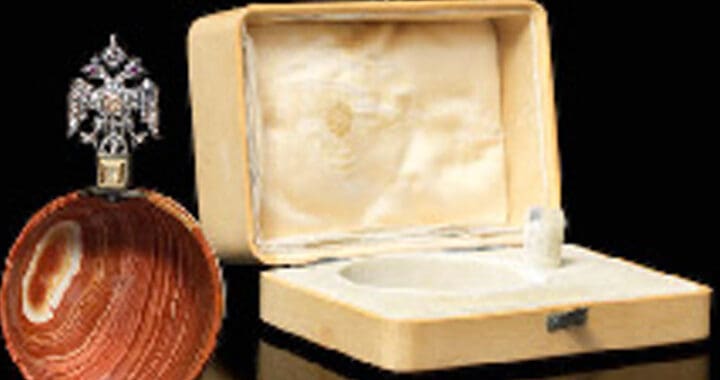The Fabergé name catapults us back to the late 19th century when the Romanovs ruled over the vast Russian Empire. The firm’s fortunes were tied to the lavish spending of an international network of royalty and socialites, until the first world war took its toll on such conspicuous consumption. When the House of Fabergé folded in 1918 alongside the collapse of the Russian monarchy, the Soviet authorities lost no time in nationalising personal property.

Jewelled Kovsh, 1886, presented to Victor Albert Spencer, 3rd Baron Churchill. Image courtesy of Bonhams
Although Fabergé, as a brand name, was revived to represent a string of unrelated products from fragrance and toiletries to household bleach, its association with Imperial splendour was never fully extinguished. Beginning in the 1920’s Western dealers acquired art that was considered ideologically surplus to Soviet requirements. A lucrative market for Fabergé was established, particularly in America, and inspired the trade of spurious ‘Fauxbergé’.
Russia has since re-established its purchasing power and, with it, an unflagging appetite to repatriate its lost patrimony. The learning curve necessary to negotiate heavily restored and imitation pieces is steep. Longstanding collectors who have experienced sharp fluctuations of dizzying prices and market corrections are, as a result, increasingly discerning.

Victor Albert Spencer, 3rd Baron Churchill
A recent Russian sale at Bonhams featured a jewelled kovsh (pictured) presented by Emperor Nicholas II to an acquaintance, Victor Albert Spencer, 3rd Baron Churchill, at Balmoral in 1896. As the son of Queen Victoria’s longest service Lady of the Bedchamber, Churchill grew up in the royal household and moved in court circles. The presentation gift, shaped as an abbreviated ladle carved of agate stone, was enhanced by a jewelled double-headed eagle on its handle. This underscored the Imperial provenance and the bowl carved of native hardstone acted as a reminder of Russia’s vast mineral wealth.

One of Faberge’s legendary Easter designs, The Rose Trellis Egg (1907) Courtesy of The Walters Art Museum
Hallmarks confirmed the gift was the work of Michael Perchin, head workmaster for Fabergé in St. Petersburg in 1896. Further inventory numbers scratched on the handle matched up with the firm’s surviving ledgers, corroborating the kovsh’s purchase by the Imperial Cabinet: the office in charge of the treasury, property and institutions belonging to the Russian Imperial family. The Cabinet’s list documenting gifts offered by their Imperial Highnesses abroad in 1896 cited Churchill as the recipient.

Emperor Nicholas II, the last ruling Romanov, and family
The original sale invoice from Fabergé of 335 roubles represented a considerable amount of money. A 1902 Baedecker travel guide suggested budgeting 6-10 roubles for a night’s stay at the legendary Europa Hotel in St. Petersburg, so the presentation was a generous gift to an English acquaintance held in high esteem.
Clarifying the kovsh’s documented provenance offered the buying public the fullest understanding of its historical context and attracted a great deal of interest at Bonhams in November 2018. Churchill’s descendants were gratified by the results of their consignment to the Russian auction when the kovsh sold for £236,750.
As is often the case, Fabergé objects in private hands are repeatedly undervalued as the market has recently become more buoyant, scholarship has advanced considerably and access to Russian archives has improved. It is therefore imperative that any insurance valuation be refreshed every three years and required where none has been undertaken within five.
Call us today to enquire about an appointment on 01883 722736 or email
[email protected] or visit our website www.doerrvaluations.co.uk






